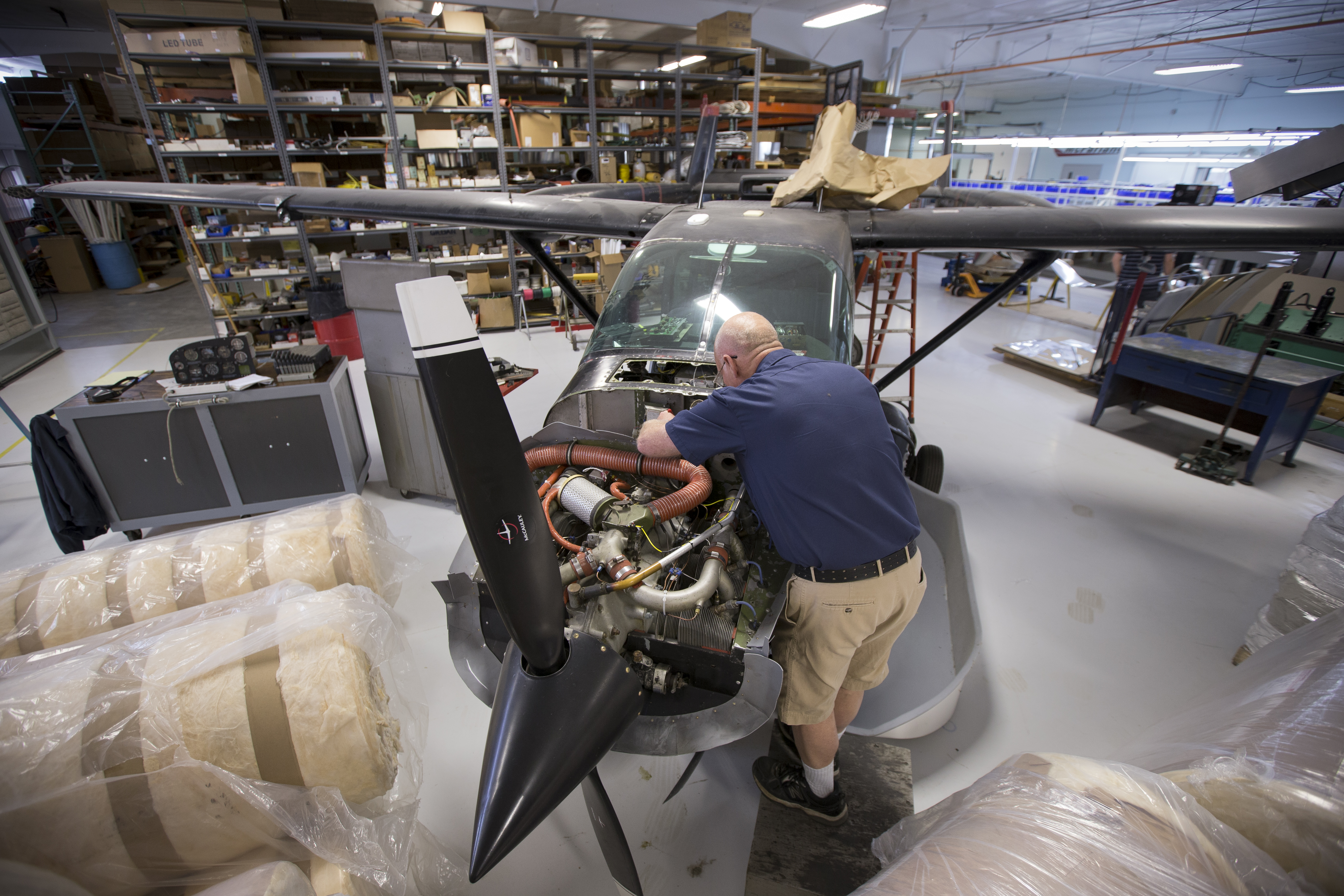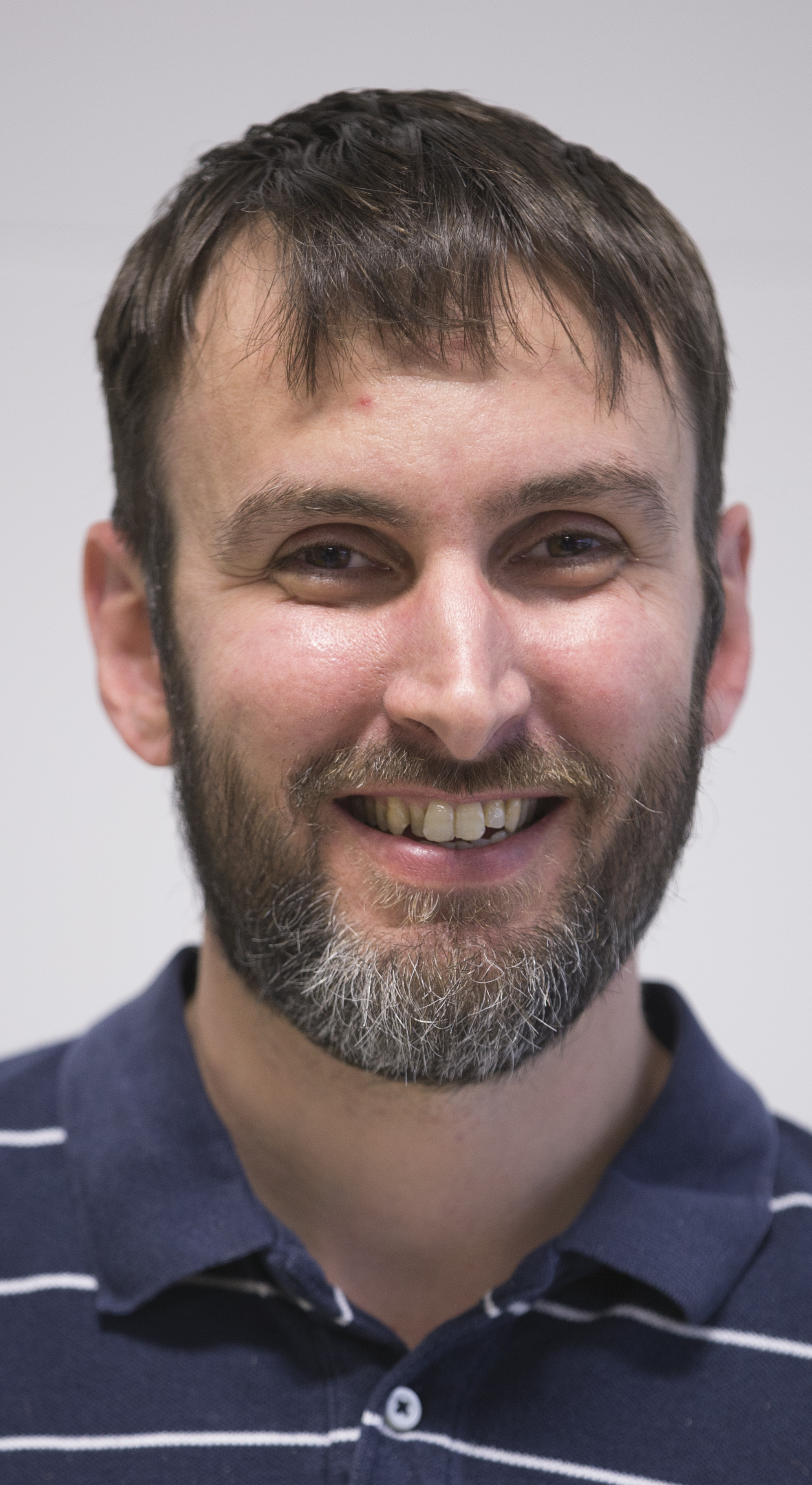McFarlane Aviation expanding in Vinland with eye toward aerospace industry

photo by: Nick Krug
McFarlane Aviation mechanic Andy Pritchard hunches over the engine of a Cessna 337 Spymaster during an annual inspection at the aviation parts and production facility on Thursday, May 5, 2016, at McFarlane Aviation, 696 East 1700 Road in Vinland.
At first glance, the bottle opener Dan McFarlane displays to illustrate the new manufacturing process McFarlane Aviation plans for its Vinland plant doesn’t look much different from other metal bottle openers.
It has the same bend near the business end as most openers that fit on key chains, and has a mouth that fits snuggly on the bottle cap. What sets it apart are the numerous perforated raindrop-shaped holes in what McFarlane reveals is a titanium body.
“This is probably the most over-engineered bottle opener in existence,” he said.
The holes are meant to show off its fabrication through the additive manufacturing process, the industry term for the use of 3-D printers to build parts following the instructions of a computer program. The opener was built as the printer laid down successive layers of laser-melted, powdered titanium, McFarlane said.
About 100 yards from where the general manager of McFarlane Aviation was standing, the metal skin is going on the exterior of a 24,000-square-foot building. In July, some of McFarlane’s existing operations will expand into to half of the new building. A new sister company specializing in additive manufacturing, McFarlane AMS, will set up shop in the remaining half.
“This technique complements what we do here,” he said. “But it is also our hope it will allow us to branch out and reach new customers in the aerospace industry.”
McFarlane said the company has been studying additive manufacturing technology for about 18 months. The impetus was a NASA consultant he partnered with on projects while an aeronautical engineering student in college, he said.
Despite the investment in a new building, don’t expect McFarlane AMS to begin printing out parts for NASA and aerospace customers with its completion. That won’t happen until the Federal Aviation Administration agrees the new parts are as safe as those manufactured with traditional processes.
“The challenge is FAA certification,” McFarlane said. “It’s basically a new manufacturing process with not enough history of durability or reliability. We will be working closely with the FAA to certify those processes. It’s a lot of testing and a lot of research and development.”
Those startup costs coupled with the nearly $1 million price tag for each of the state-of-the art printers has the company looking for a partner to get the venture started. McFarlane said negotiations were ongoing with a couple of obvious candidates who have a stake in seeing the FAA certification process move forward.
“We’re leveraging our existing engineering and quality control resources to get this off the ground,” he said. “Because we’re investing so much to get FAA certification and in infrastructure, we will be partnering with a machine manufacturer who sees the value of what we are doing. We’re going to be the one that gets it up and going for the broader aerospace industry.”

photo by: Nick Krug
Dan McFarlane
The two 3-D printing machines the company will install have 12-inch cubic printing chambers, McFarlane said. The printing process can be lengthy, up to 10 minutes per part, and requires considerable advanced programing and engineering.
“Where you get your best value in production is in making multiple pieces or high-value parts,” McFarlane said.
Again, it is those holes in the bottle opener that reveal the 3-D printing’s promise in “topography optimization,” or obtaining maximum strength with minimum weight. The machines can be programed to print parts with weight-reducing holes or lattice-work structures on a much smaller scale than traditional milling or casting methods while retaining strength and stiffness. Because those features are integrated into a part’s manufacturing process, additive manufacturing turns on its head traditional industrial cost ratios.
“With traditional machining, the more complex and intricate a part is the more expensive it is to manufacture,” McFarlane said. “With this, the more complex a part is, the less expensive it is to make because there is less base metal used.”
“It’s also a very green technology. With milling, up to 60 percent of metal is waste or is recycled. This uses 99 percent of the base metal.”
The process does have limitations, and parts may need a polishing finish applied by traditional methods, McFarlane said. That is one way the company’s existing operations will complement the new venture, he said.
The continued growth of and demand for established product lines also created demand for the expansion. Shipping offices are among the current operations that will move into the new building, allowing more room for fabrication and providing additional office space for engineering and accounting in existing buildings, McFarlane said.
The company grew from the aircraft maintenance business McFarlane’s father, Dave McFarlane, and his partner, Fred McClenahan, started in 1970 at Vinland Valley Aerodrome, which McFarlane still owns. The two men started fabricating frequently replaced seat rollers and washers for Cessnas, which were soon recognized as superior in design and durability to those then available.
Airplanes are not part of modern disposable culture. Because of the high cost of new planes, there is a demand for parts to keep 40- and 50-year-old planes flying. In 1993, McFarlane and McClenahan started focusing on the parts business.
The company currently manufactures or markets for other companies an ever-expanding product line of more than 2,000 parts, which includes such things as O-rings, throttle and control cables and skins for wing flaps, rudders or ailerons. True to its tradition, McFarlane Aviation continues to improve those parts through design and materials, such as the replacement of fiberglass in one part with Kevlar.
Growth has spurred past plant expansions in 1997, 2005 and 2011.
The company her father founded with his name had nurtured success through a “slow and steady” approach to growth, said Cheryl Kurtz, McFarlane Aviation’s human resource director and controller.
“We average adding five new employees a year,” she said. “We’re not the kind of company that hires 40 new people a year.”
Those driving by the Vinland complex sometimes assume its size equates to a much larger workforce than the 68 full-time employees and about eight part-timers who work there, Kurtz said. Much of the interior space is devoted to storing parts, she explained.
“We stock so much inventory because it is cost effective,” she said.
Becoming a pioneer in a new 3-D printing manufacturing process might seem at odds with the company’s slow-and-steady approach, but McFarlane and Kurtz continually stressed that it complemented existing operations. Her father and the company had thoroughly considered the risks and opportunities of the move, Kurtz said.
“Dave is a former crop duster,” she said. “That tells you the level of calculated risk he is capable of.”







